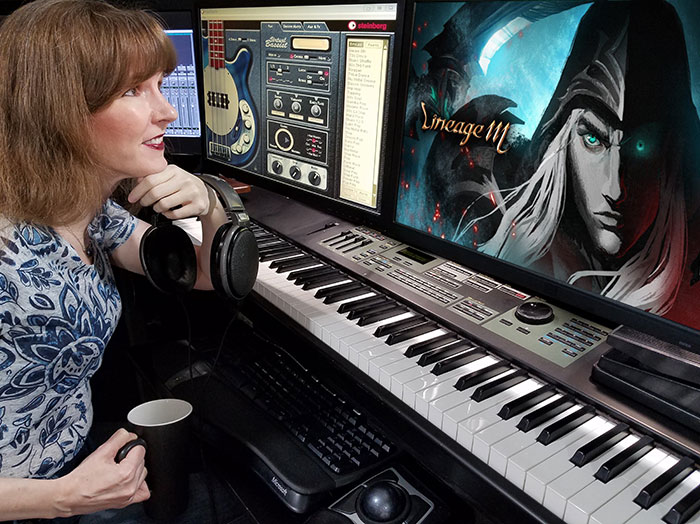
Featured Blog | This community-written post highlights the best of what the game industry has to offer. Read more like it on the Game Developer Blogs.
This article discusses the process of creating rhythmic and melodic diversity in a system based on horizontal segmentation for the music of Lineage M: The Elmor, by video game composer Winifred Phillips.

By Winifred Phillips | Contact | Follow
Hey everybody! I'm video game composer Winifred Phillips. Thanks for joining me for this second article in my series based on my Game Developers Conference 2022 lecture, "Composing for Lineage M: Modular Construction in Game Music." In my GDC presentation, I discussed my work composing music for a recent installment in the famous Lineage franchise (one of the most popular MMORPG game series ever made). This article series will share the content of that GDC talk, along with the audiovisual samples I included in my presentation at the conference.
In the first article of this series, we explored how retro gaming has made an awesome impact on the game industry, leading to the release of a port of the original Lineage PC game for mobile devices under the name Lineage M. We also discussed the brand new gothic DLC content for this game, entitled Lineage M: The Elmor.

I shared my experience being hired to compose new music for DLC content supplementing a game originally released over 24 years ago. We discussed how traditional interactive music approaches were adapted to this game's retro music system, and how a modular approach was crucial to the music implementation strategy for this project. You'll find all these ideas discussed in detail in part one of this article series.
Continuing our discussion of modular music system, let's pick up with the idea of structural compatibility. If all the internal elements of a game's musical score are designed to be compatible with each other, this is a great way to enable the modular approach. In the gameplay music for Lineage M: The Elmor, everything was designed for compatibility. For instance, I composed all of the gameplay music for Lineage M in E minor at 130 beats per measure – it’s all structured around those two immovable factors. This enables the modular construction, and there are pros and cons to this approach. Having a cohesive tonal center and pacing helps to instill aesthetic unity into all the in-game tracks. But we need to take care that there’s still diversity and variation, despite the common tempo and key signature. So let’s look at some of the ways that issue was addressed for the music of Lineage M: The Elmor.

The city of Escaros is located in the larger kingdom of Elmor, and the playable landscape includes five distinct territories: The Cave of Sorrows, the Plains of Silence, the City Walls, the Sacred District, and the City Center. For each of these territories, I composed a group of musical sections, each lasting 8 measures. The sections could be taken in any order, and were frequently juggled to help keep the music feeling fresh. The philosophy behind this approach bears a strong similarity to the Horizontal Resequencing method of dynamic construction, long favored by game audio experts for modern interactive music design. I discussed this idea in my book, A Composer's Guide to Game Music (The MIT Press):
"In music, we mentally picture the ephemeral concept of time as a horizontal phenomenon, moving inexorably from left to right (like the notes on a musical staff). Likewise, most audio editing software visually presents audio as a waveform moving horizontally from left to right. The fundamental idea behind horizontal re-sequencing is that when compose carefully and according to certain rules, the sequence of a musical composition can be rearranged. This process occurs while the music continues to move forward on the horizontal axis of time, allowing a continuous free-flowing transformation of musical content." (Chapter 11, Page 188) |
For each of the five territories that comprise the city of Escaros, I prepared an assortment of 8-measure musical segments. Because the music had been purposefully divided into these distinct sections of equivalent length, they were capable of being freely rearranged. This helped to instill variety into the music over time. The sections were also designed so that their instrumentation could be taken apart with fine detail, allowing them to be stripped down to a spare atmospheric mix, or built up in complexity and momentum. Each of these instrumental recordings could also be mixed and matched between the sections – so they weren’t functioning solely as individual music compositions, but also as sets of modular components. The sections cross-fertilized each other, not only within the gameplay territories, but also between them. For instance, a melodic phrase or instrumental performance from The Cave of Sorrows might reappear during the City Walls sequence, or in the Sacred District. It was a flexible system that instilled a sense of unified musical identity across the game’s new playable territories.

So let’s start examining the music of those five gameplay territories, starting from the foundation of the modular structure. Here’s a brief taste of the most low-keyed, ambient content in the modular system, organized by gameplay territories:
Now let’s add some rhythm on top of a few of these sections, so that we can see how they’re distinguished by the territory for which they’re written. Rhythmic changes help to introduce variety into the musical structure, even though the meter and tempo remain fixed. Notice that the meter sometimes shifts from straight common time to compound quadruple meter, but this doesn’t bring about any alteration to the tempo, and it doesn’t change the downbeat placement.
In addition to rhythmic changes, many of the sections incorporate melodies – and sometimes countermelodies – into the modular system. These melodic lines were written for particular territories in the city of Escaros such as the Cave of Sorrows or the Sacred District. We’ll be checking out how all of this functions in-game later in this series of articles, but first let’s get a taste of some melodic content from this music system.
Finally, the instrumental performances of these melodies were treated as modular components, so they could be easily transplanted from one section to another. In order to best understand the structure of these recordings within the modular system, we'll need to discuss the role of stemming in the modular approach, and the division of single instrumental performances into multiple modules. Since this is a more complex topic, we'll tackle that discussion in the next article. Until then, thanks very much for reading!

Winifred Phillips is a BAFTA-nominated video game composer whose most recent project is the music for one of the latest blockbuster releases in the Lineage series (one of the highest-grossing video game franchises of all time). Recent projects include the hit PlayStation 5 launch title Sackboy: A Big Adventure (soundtrack album now available). Phillips’ popular and award-winning Assassin’s Creed Liberation score was recently singled out by GameSpot as their favorite in the franchise, naming it one of the "best video game soundtracks you can stream." As an accomplished video game composer, Phillips is best known for composing music for games in five of the most famous and popular franchises in gaming: God of War, Total War, The Sims, Assassin’s Creed, and Sackboy / LittleBigPlanet Phillips has received numerous awards, including an Interactive Achievement Award / D.I.C.E. Award from the Academy of Interactive Arts and Sciences, six Game Audio Network Guild Awards (including Music of the Year), and three Hollywood Music in Media Awards. She is the author of the award-winning bestseller A COMPOSER’S GUIDE TO GAME MUSIC, published by the MIT Press. As one of the foremost authorities on music for interactive entertainment, Winifred Phillips has given lectures at the Library of Congress in Washington DC, the Society of Composers and Lyricists, the Game Developers Conference, the Audio Engineering Society, and many more. Phillips’ enthusiastic fans showered her with questions during a Reddit Ask-Me-Anything session that went viral, hit the Reddit front page, received 14.9 thousand upvotes, and became one of the most popular gaming AMAs ever hosted on Reddit. An interview with her is now featured as a part of the Routledge text, Women's Music for the Screen: Diverse Narratives in Sound, which collects the viewpoints of the most esteemed female composers in film, television, and games. Follow her on Twitter @winphillips.
Read more about:
Featured BlogsAbout the Author(s)
You May Also Like









